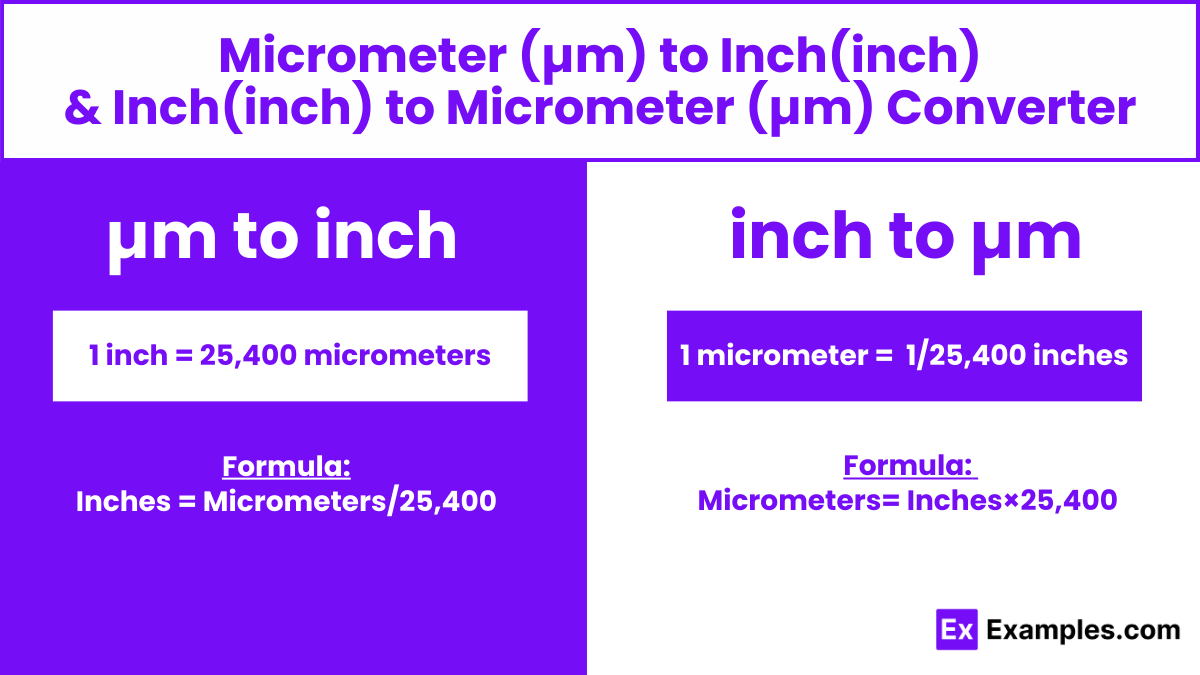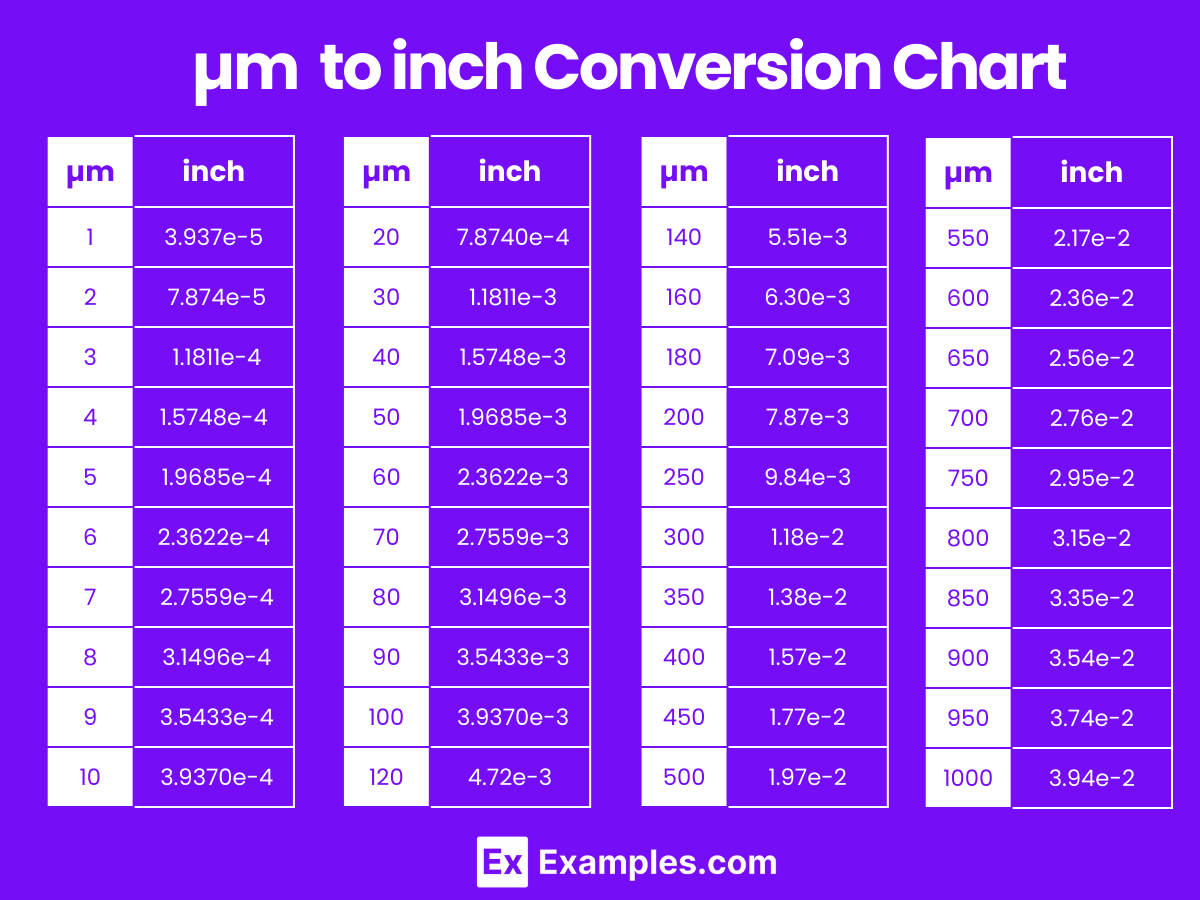Effortlessly convert micrometers to inches and vice versa with our accurate tool on examples.com, ideal for precise measurements in various applications.
µm to inch
Formula: Length in inches (inch) = Length in micrometers (µm) ÷ 25400
Micrometer:
Inch:
| Micrometers | Inches | Exponential Form (inch) |
|---|---|---|
| 1 | 0.0000393701 | 3.937e-5 |
inch to µm
Formula: Length in micrometers (µm) = Length in inches (inch) × 25400
Inch:
Micrometer :
| Inches | Micrometers |
|---|---|
| 1 | 25400 |
Length Converters to Micrometer (µm)
Length Converters to Inch (in)
| Kilometer to Inch | Meter to Inch | Centimeter to Inch |
| Millimeter to Inch | Micrometer to Inch | Nanometer to Inch |
| Mile to Inch | Yard to Inch | Feet to Inch |
| Nautical Mile to Inch |
Conversion Factors:
- Micrometers to Inches: 1 inch = 25,400 micrometers
- Inches to Micrometers: 1 micrometer = 1/25,400 inches
How to Convert Micrometers to Inches:
To convert micrometer to inche, divide the number of micrometers by 25,400.
Inches=Micrometers/25,400
Example: Convert 10,000 micrometers to inches.
Inches=10,000/25,400≈0.3937 inches
How to Convert Inches to Micrometers:
To convert inch to micrometer, multiply the number of inches by 25,400.
Micrometers=Inches×25,400
Example: Convert 2 inches to micrometers.
Micrometers=2×25,400=50,800 µm

Micrometers to Inches Conversion Table
| Micrometers (µm) | Inches (in) |
|---|---|
| 1 µm | 3.937e-5 in |
| 2 µm | 7.874e-5 in |
| 3 µm | 1.1811e-4 in |
| 4 µm | 1.5748e-4 in |
| 5 µm | 1.9685e-4 in |
| 6 µm | 2.3622e-4 in |
| 7 µm | 2.7559e-4 in |
| 8 µm | 3.1496e-4 in |
| 9 µm | 3.5433e-4 in |
| 10 µm | 3.9370e-4 in |
| 20 µm | 7.8740e-4 in |
| 30 µm | 1.1811e-3 in |
| 40 µm | 1.5748e-3 in |
| 50 µm | 1.9685e-3 in |
| 60 µm | 2.3622e-3 in |
| 70 µm | 2.7559e-3 in |
| 80 µm | 3.1496e-3 in |
| 90 µm | 3.5433e-3 in |
| 100 µm | 3.9370e-3 in |
µm to inch Conversion Chart

Inches to Micrometers Conversion Table
| Inches (in) | Micrometers (µm) |
|---|---|
| 1 in | 25,400 µm |
| 2 in | 50,800 µm |
| 3 in | 76,200 µm |
| 4 in | 101,600 µm |
| 5 in | 127,000 µm |
| 6 in | 152,400 µm |
| 7 in | 177,800 µm |
| 8 in | 203,200 µm |
| 9 in | 228,600 µm |
| 10 in | 254,000 µm |
| 20 in | 508,000 µm |
| 30 in | 762,000 µm |
| 40 in | 1,016,000 µm |
| 50 in | 1,270,000 µm |
| 60 in | 1,524,000 µm |
| 70 in | 1,778,000 µm |
| 80 in | 2,032,000 µm |
| 90 in | 2,286,000 µm |
| 100 in | 2,540,000 µm |
inch to µm Conversion Chart
Difference Between Micrometers to Inches
| Aspect | Micrometer (µm) | Inches (in) |
|---|---|---|
| Definition | A micrometer is one-millionth of a meter (10^-6 m). It’s used to measure very small distances, such as the thickness of a cell wall or the diameter of microelectronic devices. | An inch is a unit of length in the imperial system, commonly used in the United States and the United Kingdom, defined as 25.4 millimeters or about 0.0833 feet. |
| Conversion | 1 micrometer = 0.00003937 inches. | 1 inch = 25,400 micrometers. |
| Usage | Typically used in scientific and industrial contexts for microscopic measurements. | Widely used in everyday life in the U.S. and UK, especially for measuring dimensions of objects like furniture, room sizes, and heights. |
| Precision | Provides precision at a microscopic level, suitable for measurements in fields like electronics, materials science, and engineering. | Generally used for measurements where fine precision is less critical but still important, suitable for general purpose measurements in construction and DIY projects. |
| Symbol | µm | in |
| Scale | Much smaller scale compared to an inch. Measures entities at a cellular or microscopic level. | Larger scale, commonly used for practical and everyday applications. Measures objects and distances that are easily visible and tangible. |
| Field of Application | Used in fields requiring high precision at micro scales, such as semiconductor manufacturing, nanotechnology, and microscopy. | Used in fields like construction, manufacturing, and retail, where a practical unit for everyday measurements is required. |
1. Solved Examples on Converting Micrometers to Inches
Example 1: Convert 10,000 micrometers to inches.
Inches=Micrometers/25,400
10,000/25,400≈0.3937 inches
Result: 10,000 µm = 0.3937 in
Example 2: Convert 50,000 micrometers to inches.
Inches=Micrometers/25,400
50,000/25,400≈1.9685 inches
Result: 50,000 µm = 1.9685 in
Example 3: Convert 100,000 micrometers to inches.
Inches=Micrometers/25,400
100,000/25,400≈3.9370 inches
Result: 100,000 µm = 3.9370 in
Example 4: Convert 1,000 micrometers to inches.
Inches=Micrometers/25,400=1,000/25,400≈0.0394 inches
Result: 1,000 µm = 0.0394 in
Example 5: Convert 250,000 micrometers to inches.
Inches=Micrometers/25,400
250,000/25,400≈9.8425 inches
Result: 250,000 µm = 9.8425 in
2. Solved Examples on Converting Inches to Micrometers
Example 1: Convert 1 inch to micrometers.
Micrometers=Inches×25,400
1×25,400=25,400 µm
Result: 1 in = 25,400 µm
Example 2: Convert 0.5 inches to micrometers.
Micrometers=Inches×25,400
0.5×25,400=12,700µm
Result: 0.5 in = 12,700 µm
Example 3: Convert 2 inches to micrometers.
Micrometers=Inches×25,400
2×25,400=50,800µm
Result: 2 in = 50,800 µm
Example 4: Convert 4 inches to micrometers.
Micrometers=Inches×25,400
4×25,400=101,600µm
Result: 4 in = 101,600 µm
Example 5: Convert 10 inches to micrometers.
Micrometers=Inches×25,400
10×25,400=254,000µm
Result: 10 in = 254,000 µm
1. Which lengths are equivalent to 1 μm?
One micrometer (μm), also known as a micron, is equivalent to 0.000001 meters or 1/1,000,000 of a meter. In terms of other length units, 1 micrometer is approximately equal to 0.00003937 inches, 0.001 millimeter, or 0.000001 kilometers. It’s a very small unit of length commonly used in scientific and engineering contexts for precise measurements at the microscale.
2. What is the smallest measurement in inches you can get from micrometers?
The smallest measurement you can clearly get is 0.00003937 inches, which equals one micrometer.
3. What tools can help with converting micrometers to inches?
Digital calipers, online conversion calculators, or mobile apps specifically designed for unit conversion can all help convert micrometer to inches accurately.
4. Are conversions from micrometers to inches common in science?
Yes, especially in fields like physics and materials science where materials might be measured in micrometers but other data or regulations require inches.
5. How do you ensure accuracy when converting from micrometers to inches?
Ensure accuracy by using precise tools to measure the original micrometers and by double-checking calculations with a reliable conversion tool or software.
6. What might cause errors in converting micrometers to inches?
Common errors include using an incorrect conversion factor, rounding errors, or measurement errors when initially measuring in micrometers.
7. Why are inches still used in a world that mostly uses the metric system?
Inches are still used extensively in the United States and for certain applications in other countries due to historical conventions and existing infrastructure.
8. How has digital technology impacted the use of micrometer to inch conversions?
Digital technology has made it easier to perform accurate and instant conversions, with digital tools embedded in measuring devices or available online.


